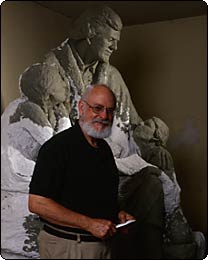The city of Shawnee is named for the Shawnee Indian tribe who occupied this area
by treaty from 1825 until about 1855, when the Kansas Territory was opened for
settlement. The Shawnee called their settlement Gum Springs.
The Gum Springs settlement was subsequently called Shawneetown, and later,
Shawnee. It was platted in 1856, and is one of the earliest towns in Kansas. Shawnee
was the site of the first territorial legislature, home to the first
territorial governor, and the first county seat of Johnson County.
Following is chronology of some of the more notable historical events in Shawnee's
history.

1541 - Spanish explorer, Francisco Vasquez de Coronado, having met great
disappointment in his search for the legendary Seven Golden Cities of Cibola,
launched his next futile search for gold in the Land of Quivira, leading him to the
Kansa River area (near Bonner Springs). Finding no gold, he returned to New Mexico.
1803 - 1806 - The United States acquires hundreds of thousands of acres in
the Louisiana Purchase, including the Shawnee area. President Thomas Jefferson
dispatches Meriwether Lewis and William Clark to explore the lands in the acquisition.
1825 - Shawnee Indians, by treaty, remove from Ohio, Pennsylvania,
Indiana, and Missouri, and headquarter in Johnson County, Kansas. Over the next
10 years, over 1,600 Shawnee relocate in Kansas.
1825 - The United States signs a treaty with the Osage Indians, giving
them right-of-way for a public highway to be known as the Santa Fe Trail.

Colonel Henry Leavenworth
1827 - Fort Leavenworth is established by Col. Henry Leavenworth on May 8,
1827, to keep peace in the Indian territory and to protect the travelers on the
Santa Fe Trail.
1830 - A smallpox epidemic kills most of the Shawnee Tribe as well as
members of other tribes. Other tribes which have arrived are the Kickapoo, Delaware,
Munsee, and Wyandot.

"The Guardian"
1830-1835 - The first wheat is grown on farms in Kansas. Three missions
are established to aid the Indians. Jotham Meeker starts the first newspaper in
Kansas, the Shawnee Sun.
1840 - More settlers travel the Santa Fe Trail between Independence,
Missouri, and Santa Fe, New Mexico. Six hundred wagon trains per week pass through
Johnson County on their way to New Mexico.
1843 - The first territorial jail is built on the square in Shawnee, where
it stood for nearly 125 years, until it was torn down, rock by rock, and rebuilt as
the first building in Old Shawnee Town.

1854 - 1860 - On May 30, 1854, the Kansas-Nebraska Act is passed and
the new Kansas Territory opens up for settlement. Shawneetown is incorporated in 1856.
Kansas begins to attract multitude of settlers. Among them is James Butler ("Wild
Bill") Hickock, who is elected constable of Monticello Township at the age of 18.
1860-1862 - The Pony Express stops at eleven stations along the Kansas
section of its route.
1861 - The eastern portion of the Kansas territory becomes the 34th state
on January 29, 1861, joining as a free state after many years of dispute.
1860s-1870s - Rev. Charles Bluejacket is elected Shawnee chief. Horse thieves are
hung by rope from a tall hickory tree in a little pioneer cemetery at 55th and
Goddard, which comes to be known as "Horse Thief Cemetery."

Artist Charles Goslin with Bluejacket statue model.
Modern-day Shawnee is a great place to live. We enjoy the history of our area, as well
as the new-fangled conveniences.
